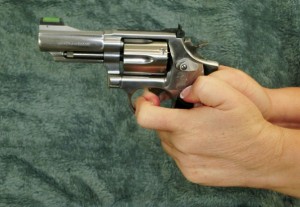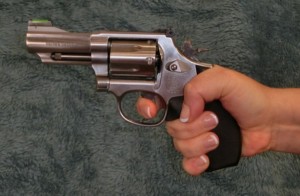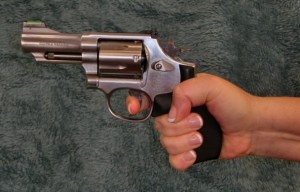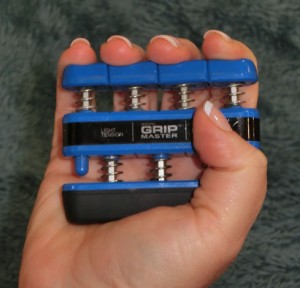Really – that’s what the guy said. It wasn’t my problem or my job to correct his wrong idea, so I bit my lip and moved on. But it reminded me of an online discussion I’d been recently involved in, and the topic does make good blogfodder, so here we are.
Let me start by saying this: If you really prefer a revolver and can easily run it, that’s a perfectly valid reason for you to use one and don’t let anyone tell you otherwise. Below, I’m talking specifically about the idea that every shooter must learn on a revolver first — or that revolvers are ideal for all women, or uniquely suited to women. It’s the one-size-fits-all approach I’m against, not against revolvers. With a few (really important) caveats, the motivation provided by using the gun a new shooter wants to learn how to shoot often trumps any specific positive or negative factors within the weapon itself.
With that out of the way, is a revolver really the “best gun for a woman”? Should all women use revolvers? I think not!
Hand Strength Issues
Over the past ten years, I’ve worked with thousands of women as they learned to shoot. To this day, I have literally never met a healthy adult woman[ref] Please note the word “healthy.” People dealing with long-term hand or arm injuries, or with arthritis and other related connective tissue disorders, often have an uphill struggle to find a gun they can trust and use well. Sometimes this includes having limitations so severe that they can find no reliable technique for operating a slide.[/ref] who could not be taught how to rack the slide on a semi-auto with less than an hour on the range — and the overwhelming majority of those women took less than 5 minutes to learn the simple technique that makes racking the slide an easy no-effort thing. Racking the slide is almost entirely a matter of technique, not strength, which means it’s something that almost anyone can easily learn how to do.
In contrast to this, I have met dozens of women who did not have the hand strength to reliably pull the trigger on a double action revolver for more than a few rounds even after repeated efforts. Being unable to pull the trigger more than a dozen times in a row does not matter for self-defense — unless it does! — but it makes regular practice nearly impossible.
The tricks you can use to make pulling a heavy revolver trigger less difficult for someone with low hand strength nearly all require you to do something contra-indicated in a self defense situation. For example, to reduce the tension on the trigger, you can cock the hammer. But that makes shooting much slower, and it’s almost impossible to safely lower the cocked hammer when you’ve had a massive adrenalin dump and your hands are shaking severely. You can use both of your index fingers on the trigger instead of one, but you may not have two hands available to use in a self-defense situation.
You can adjust where your hand rides on the gun to increase your leverage on the trigger, but that has limited effects. You can exercise to build up your hand strength (and you should!), but few people will have the dedication to do that. You can mechanically lighten the trigger pull weight, but that often comes at the expense of the gun’s reliability. Even with these mechanical adjustments, using the heavy DA trigger on a revolver remains almost entirely a matter of hand strength, not something easily addressed with a trick or technique. Not everyone can learn to do it, which means these aren’t the ideal guns for all shooters.
Recoil and Shooting Comfort

Using two fingers to pull the trigger works on the range, but in real life you may not be able to get both hands on the gun when you need it most.
In addition to the factors that apply to all revolvers, there are some factors that apply specifically to the small, lightweight models most often recommended for women. Those who shoot more than one type of gun soon discover that these super small, super lightweight revolvers are actually among the most difficult and least comfortable guns to use. Slightly larger guns tend to be much more comfortable for most shooters. This means beginners who start on a slightly larger and slightly heavier gun will more likely keep shooting, and are more likely to get the practice they need in order to build reliable self-defense skills. (I wonder how many women start out with these small guns and leave the range thinking that shooting just isn’t their cup of tea, when in fact a more comfortable early experience with shooting would have helped them continue to shoot with enthusiasm!)
Related to this, whenever you take a revolver and compare it to a semi-auto within a similar size and weight class, you’ll find that the semi-auto almost invariably provides less perceived recoil to strike with the same energy effect on target. That’s because with most semi-autos, the motion of the slide does absorb some of the rearward energy as the shot fires. That absorbed energy gives the shooter a slightly more comfortable experience — again making it easier to shoot and more likely that the shooter will practice enough.
With all of these factors in mind, my experience has been that it’s much more difficult to teach a new shooter to shoot well with a revolver than it is to teach a new shooter how to run a semi-auto and shoot well with it. There are specific skill sets unique to each type of weapon, but the most significant challenges with a semi-auto nearly all fall within the “easy to fix with the right technique” category, while those with the revolver seem to be inherent to the weapon.
What Can We Learn?
With all that said, let me add one more really (really!) important thing: Women are just as capable of learning how to shoot as men are. Women can just as easily learn how to manipulate a weapon and are just as able to learn how to run the gun in ways useful for self defense. We aren’t uniquely fragile or uniquely stupid! We’re human beings with human limitations, and with a human ability to grow and learn.
Sometimes, I meet men who have a preference for teaching women on revolvers based on … well, on a really unfortunate way of looking at women. To these guys, I have to say that if your preference for teaching with a specific weapon type is built around low expectations for your student — “It’s okay, honey, you won’t have to learn anything…” — that’s probably not going to lead to good results in the long run. You will get your best results going in with the expectation that of course this healthy adult person will be able to learn anything about the gun that she wants to learn.
Again and to be clear: I am not against revolvers. I am against the one size fits all approach to teaching new shooters or to recommending guns for women. If you love revolvers and shoot them well, more power to you! If you want to learn to shoot with a revolver, I hope you have a wonderful experience that serves you well. Your energy and enthusiasm will almost certainly see you over any rough spots you might hit along the way, and that’s a good thing.
No matter which gun type you choose, whether it’s a revolver or a semi-auto, there are a few things that you will have to learn that someone who chose the other type of gun doesn’t need to know anything about. There’s still no such thing as a gun that runs all by itself, shoots accurately without a skilled hand behind it, or cleans itself. That’s the bad news. The good news is, all of these skills are learnable skills. They aren’t black magic and they aren’t inaccessible to half the human race!








Pingback:'Perhaps a snubbie for the little lady' | The Gun Feed
Pingback:In Gun News This Week | Guns And Gunsmiths
Pingback:Women Should Always Use Revolvers | Mississippi Gun News